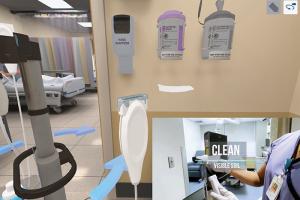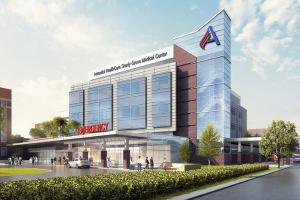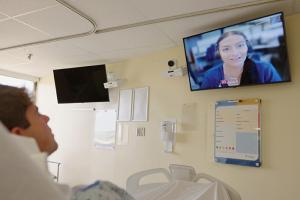Planning the connected hospital

Operating room orchestration can help reduce surgical backlogs by improving on-time surgical starts.
Image by Getty Images
Health care information technology (IT) has matured significantly over time, from being a collection of separate, siloed applications and systems to an integrated network of connected solutions that enable hospitals to be safer, healthier and more efficient.
With the right technology in place, modern hospitals can become equipped to deal with critical health care challenges around key issues such as operational throughput, infection reduction, patient experience, and creating safer and more secure environments.
Health care pain points
The health care field is undergoing a prolonged period of IT change, with hospitals benefiting greatly from technological advances. Indeed, as they adapt to embrace them, digital processes and technologies have the potential to ease a number of common pain points, including:
- Throughput optimization. Throughput optimization is the need to maximize the flow of essential medical services such as surgeries, diagnostic imaging and emergency room (ER) activities. It also encompasses daily processes such as bed management, patient transportation and room hygiene. The problem is that low or inefficient throughput impacts income, profitability, resource utilization, patient satisfaction and hospital reputation.
- Revenue generation. The recent period of high demand for critical hospital services has put pressure on hospitals to prioritize these over less urgent services. This has created a significant backlog of elective surgeries and other revenue-generating services, as noted by Harvard Business Review. To compensate, medical institutions need to find alternative revenue sources and cost savings. Throughput optimization is the need to maximize the flow of essential medical services such as surgeries, diagnostic imaging and ER activities.
- Healthier environments. The need to maintain clean and healthier environments across the facility creates another set of pressures for hospitals. Having a healthier hospital means monitoring and maintaining environmental quality factors such as airflow, directional pressure and air quality, which can be achieved through processes such as filtration of particles and pathogens to higher performance HVAC solutions, which has become even more critical during the recent pandemic.
- Infection reduction. Also crucial is the need to lower infection rates, both health care-associated infections and surgical site infections (SSIs). These have posed a long-standing problem, with SSIs costing U.S. hospitals tens of billions of dollars annually, according to the Centers for Disease Control and Prevention. Best practices such as hand hygiene, instrumentation sterilization and environmental quality monitoring can all play a part in helping to meet infection reduction goals.
- Patient experience. Improving the patient and employee experience is also a high priority for modern health care facilities. This can deliver a variety of positive outcomes that range from reducing patient readmission rates to enabling staff to be more productive and efficient. Outcomes like these can affect the organization’s bottom line, making this a high priority.
- Safety and security. Last but not least is the pressing need to improve safety and security levels across the hospital facility. In reality, creating safer and more secure environments is fundamental to building healthy hospitals, particularly with concerns over infection rates and cybersecurity threats. Cyber criminals continue to pose an ever-present danger. Another important component to creating safer and more secure hospitals is an integrated fire safety system. In a health care facility, these systems are crucial in providing warnings early enough to allow local control and mitigation. The No. 1 priority is early detection and verification, avoiding the need to evacuate large numbers of ill, incapacitated and highly vulnerable patients. Hospitals and health care facilities are facing challenges on a number of fronts at present. They are working to improve operational throughput efficiency, achieve infection reduction and positive patient outcomes, enhance the patient and employee experience, and optimize their safety, security and facilities management. The stakes are high, but with the right technology solutions, systems and processes in place, it is possible to positively impact all of these areas.
Connected hospitals
Health care IT has come a long way in terms of what it can do for hospitals and clinics, its usability and manageability, and how different platforms and applications work together. There is a growing trend toward integrating hospital systems together: integrating independent, siloed technology stacks and standalone medical, business and building management systems such as HVAC and facilities management and bringing them together on a converged network.
Connected hospital transformation is foremost about people, process and engagement. The aim is to leverage technology as a fundamental enabler of the hospital’s organizational strategy. One key advantage of doing this is efficiency: to create greater operational effectiveness and critical workflow optimization — the ability to centrally monitor, align and manage multiple different processes. The second benefit is financial. Connected hospitals can use their integrated technology platform for generating revenues and for cost control and avoidance. Third, uniting multiple technology domains gives hospitals the tools they need to improve the patient experience and staff satisfaction through innovations such as patient self-service portals and mobile apps for clinical and auxiliary staff.
Hospitals can experience even deeper levels of functionality beyond these by integrating their business, clinical and billing systems, and by adding data analytics, AI-enhanced services, dashboards and automation that can connect and speed up processes behind the scenes. To achieve these additional benefits, there is a vast ecosystem of health care apps and solutions available from health care technology specialists like Honeywell International Inc., Charlotte, N.C., and its third-party partners whose solutions can be integrated into Honeywell’s connected hospital platform.
So, by linking systems across the facility, hospitals can create more efficient workflows and use cases that drive operational efficiency and patient satisfaction.
Integrated platform
Honeywell has developed an integrated, cyber-secure technology platform designed for health care. It provides an intuitive user interface across multiple technology domains and is built using open standards. This enables it to integrate with an ecosystem of specialized hospital applications from third-party providers, engineered to address issues of operational throughput, safety and security, infection reduction and patient satisfaction.
The platform works by connecting through the health care institution’s networking infrastructure via the enterprise service bus. It is open at the “top” of the IT stack, allowing for the development of specialized vertical applications, and at the “bottom,” enabling it to connect to more than 600 commonly used vertical point solutions. Among these are real-time locating systems (RTLS), mobile devices, nurse call, HVAC and security access control, as well as fire and life safety systems.
Rather than having to opt for a rip and replace route, hospitals can leverage their existing investment in infrastructure with Honeywell’s smart integration layer, which means they don’t have to start afresh with a new integrated system. As a result, they can reach technology maturity in increments, adding new functionality over time. This enables the organization to develop its digital health care infrastructure gradually while benefiting practically from each new use case, and gaining process efficiencies, savings and return on investment. Three practical ways an integrated approach can make a difference to a hospital environment include:
- Facility operations. From a facility operations perspective, integrating HVAC controls and strategies into the hospital’s broader technology ecosystem will help it to meet emerging health care guideline requirements. These include the new infectious aerosols recommendations for higher air changes per hour, the use of directional pressure-controlled ventilation, and the need for improved unoccupied space ventilation control strategies. According to ASHRAE, the risk of pathogen spread and the number of people exposed can be positively or negatively affected by airflow patterns in a space and by HVAC and local exhaust ventilation systems. So, having the means to intelligently control HVAC levels across a facility will help to enable the healthier hospital that is proactive and compliant when it comes to air quality.
- Security. An integrated hospital infrastructure can also enable improvements in patient and staff safety and compliance. For example, applications can be added to the network that address fall risk prevention, staff duress, infant abduction, asset security and compliance, patient wandering and fire detection. With access to centralized dashboards and controls, managers, administrators and security personnel have the information they need at their fingertips so they can mitigate risks quickly such as by locking down specific areas, and protecting patients, staff, assets and equipment.
- Patient outcomes. An integrated platform can be used to facilitate positive patient outcomes such as by helping to reduce patient readmission rates through bedside patient education and self-service. And by integrating patients’ electronic health records (EHR) with medical analyses, doctors, nurses and clinicians can gain real-time decision-making advantages and workflow efficiencies. This, in turn, helps to create positive patient outcomes, as patients experience faster, smarter and more efficient services. With access to centralized dashboards and controls, managers, administrators and security personnel have the information they need at their fingertips so they can mitigate risks quickly.
Compliance to revenue
Another benefit of having a connected hospital solution is it can help organizations move away from systems that are compliance focused but offer little return on investment (ROI) and toward ones that deliver ROI, patient satisfaction and even revenue generating opportunities. Clinical workflows and RTLS are great examples of use cases where hospitals focus on meeting their compliance requirements through technology investment with little return because these systems are only used in emergencies such as for staff duress, infant protection and patient wandering. An integrated platform can, instead, enable organizations to start using their technology to drive positive financial impact for their institution, and develop activities that have good ROI and a significant impact on staff productivity, patient satisfaction and, by extension, revenues and profitability. Good examples include the following:
- Efficient operating rooms. OR orchestration can help reduce surgical backlogs by improving on-time surgical starts. The way it works is by integrating RTLS tagging, for both human and physical assets using radio frequency identification, with the EHR system to confirm that all required equipment is in the OR for the scheduled surgery. The system then confirms the patient is in pre-op and ready to be wheeled into the OR. Next, it sends an automated notification through a mobile app to confirm that pre-op setup for the OR has been carried out. The patient then receives surgery. Using an app, the nurse notifies the system that the surgery is complete, and environmental services are notified to prep the OR for the next surgery, facilitating a faster turnover. The OR is prepped for the next surgery, and a notification is sent and tracked through the mobile app. The surgical team is notified about the next case, and the OR is ready for surgery once again. In addition, OR orchestration can use analytics to update the OR scheduling model to optimize OR utilization. Having a connected hospital solution can help organizations move away from systems that are compliance-focused but offer little ROI and toward ones that deliver ROI, patient satisfaction and even revenue-generating opportunities.
- Improving hand hygiene. Hand hygiene is another process that can lead to better outcomes when enhanced with connected technology. It works by being a networked solution that uses RTLS badges and connected dispensers to log when nursing and clinical staff use hand dispensers, alerting them if they forget. This solution positively impacts operational throughput, infection reduction and patient satisfaction.
- HVAC system optimization. Honeywell’s integrated health care platform also can optimize the hospital’s HVAC system, which is of particular benefit to the OR and other critical care spaces like an intensive care unit. The system establishes predefined environmental conditions needed for that procedure for varying types of surgeries, doctor preferences or even high-risk Code Blue situations. These settings are linked to the building management system (BMS), hospital information system and OR scheduling systems. For example, in an OR, a digital display visualizes OR conditions for the surgical, infection prevention and facility team to verify, such as temperature, relative humidity, occupancy, particle count, room pressure and air changes. Meanwhile, the BMS system tracks the OR condition for ongoing reporting and compliance purposes. And when the OR is not in use, the HVAC system cycles to its set standby condition to conserve power and resources, ready for the next surgical event all the while monitoring the environmental quality.
Strategic goals
Honeywell’s approach to building the connected hospital of the future is to begin with each hospital's strategic goals, annual operating plan and achievement aims. Its methodology is patient- and staff-focused and experience-based, designed to understand what the hospital’s critical needs and particular use case is to determine the technology needed to bring improvements. Honeywell then takes a collaborative, consultative and flexible approach, working closely with the organization to prioritize individual use cases in order to triage the highest priority outcomes by incorporating the best technology or functionality for the purpose. As a result, with Honeywell’s integrated technology platform for health care, hospitals and clinics can become healthier, safer, more efficient and more profitable, with an IT infrastructure that’s future ready. And that is how the connected hospital of the future is built.
To learn more about Honeywell products or to speak to the company’s experts, visit its website.
Manish Sharma is chief technology officer and vice president at Honeywell, Atlanta. He can be reached at Manish.Sharma@Honeywell.com.




